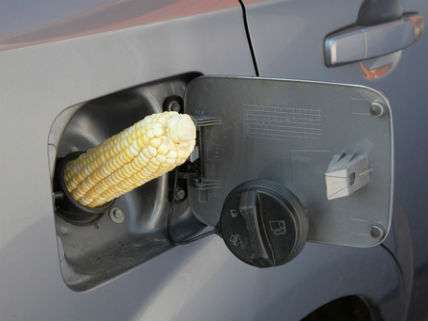Mandated Biofuels = More Greenhouse Gases
Politicians adopt a policy that does the opposite of what they supposedly intended to do.

Democratic presidential candidate Hillary Clinton and Republican presidential candidate Donald Trump agree on at least one thing. Both support the federal Renewable Fuels Standard (RFS), which mandates the production of billions of gallons of biofuels.
When asked at the Iowa Faith and Freedom Coalition banquet if he supported it, Trump replied, "Yes, and a very strong yes. There is no reason not to. We need it. We need every form we can get. Ethanol is terrific, especially with the new process. And I am totally in favor of ethanol 100-percent and I will support it." In a 2015 Cedar Rapids Gazette op-ed, Clinton declared, "The United States should also continue supporting—and improving—the Renewable Fuel Standard and other federal incentives that have been a success for Iowa and much of rural America." Trump is more interested in biofuels as replacements for imported oil, but Clinton notes that they "can also play an important role in reducing carbon emissions." (Clinton may now be backtracking on her support of the RFS.)
The RFS was passed as part of the Energy Policy Act of 2005, and it mandates the production of 36 billion gallons of biofuels by 2022. The Environmental Protection Agency (EPA) calculates that substituting biofuels for gasoline and diesel will reduce greenhouse gas emissions by 138 million metric tons by that time.
Not so fast, a group of University of Minnesota researchers say in a new study for the journal Energy Policy. They argue that the biofuels mandate is more likely to increase than reduce overall greenhouse gas emissions from the U.S. transportation sector. Why? The rebound effect.
The rebound effect can be illustrated by a consumer who buys a more fuel-efficient car, sees that the fuel costs of driving have been reduced, and thus drives more, partly negating the energy and greenhouse reductions that are supposed to result from fuel-efficiency mandates. In some cases, the rebound is greater than the initial energy savings, so consumers end up using more energy and emitting more greenhouse gases than before. This phenomenon is known as "backfire." The Minnesota researchers' study calculates that that is what will happen with the RFS—that it will backfire and result in more rather than less greenhouse gas emissions.
"The amount of fossil fuel displaced by a low-carbon fuel is determined by the economic forces of supply and demand," the authors observe. "In general, an increase in fuel supply causes a decrease in fuel prices, which in turn encourages greater fuel consumption." The authors conservatively estimate, based on an extensive survey of previous research, that about a half-gallon of gasoline is displaced by the energy equivalent of a gallon of biofuel. In other words, they assume a 50 percent gasoline displacement rate.
The RFS has different tiers of biofuels. Conventional biofuels, such as corn ethanol, are supposed to emit 20 percent less greenhouse gases than gasoline. The advanced biofuels used to replace diesel are supposed to emit 50 percent less, and cellulosic biofuels 60 percent less, than burning gasoline.
The researchers first calculate what the effect on greenhouse gas emissions in 2022 would be if each gallon of biofuel fully replaced a gallon of gasoline or diesel fuel. In other words, no rebound effect. They get a reduction of 110 metric tons of greenhouse gases, which is pretty close to the EPA's estimate.
After crunching the numbers this means that the biodiesel mandate in which the fuels are supposed to reduce greenhouse gas emissions by 50 percent of the fossil fuel equivalent is a wash—no increase in emissions, but no reductions either.
Focusing on the biofuels that aim to substitute for gasoline by 2022, the researchers find that the cellulosic biofuels should cut emissions by 12 million metric tons annually. This seems a bit optimistic, since the Energy Policy Act mandated the production of 4.25 billion gallons of cellulosic biofuels by this year, and EPA projects that only 230 million gallons will actually be produced.
In any case, the researchers calculate that burning mandated conventional biofuels—those whose emissions of greenhouse gases are 20 percent lower than a gallon of gasoline—will backfire with respect to the goal of reducing greenhouse gas emissions. The RFS mandates that 15 billion gallons of conventional biofuels be blended into the U.S. transport fuel supply by 2022. Remember that a gallon of these biofuels is expected to displace only half a gallon of gasoline. So instead of cutting gasoline consumption by 15 billion gallons, they will reduce it by 7.5 billion gallons. The upshot is that rather than decreasing greenhouse gas emissions by 23 million metric tons annually as intended, this part of the biofuels mandate will actually boost emissions by extra 34 million metric tons each year.
Presupposing that burning cellulosic biofuels offsets those emissions by 12 million metric tons, the mandate's emissions backfire is an additional 22 million metric tons of greenhouse gases per year. Due to the fuel market rebound effect, cumulative greenhouse gas emissions will rise 431 million metric tons instead of falling 749 million metric tons by 2022.
The researchers conclude that if politicians really want to cut greenhouse gas emissions, they will have to increase the price of fossil fuels. They recommend a carbon tax as the most efficient way to achieve that goal. Instead, politicians adopted a policy that actually lowers fuel prices and thus ends up increasing greenhouse emissions: the exact opposite of what they supposedly intended to do.
For more on background on energy rebound, see my article "The Paradox of Energy Efficiency."


Show Comments (193)